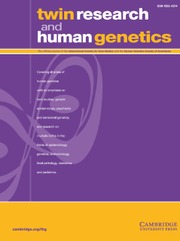No CrossRef data available.
Article contents
Is the General Factor of Personality an Entity? Testing Reflective, Formative, and Mixed Models of Polygenic Score Influence Using the English Longitudinal Study of Aging
Published online by Cambridge University Press: 30 September 2025
Abstract
Leveraging a unique dataset (the English Longitudinal Study of Aging) containing polygenic scores (PGSs) — estimated using meta-analytically-derived single nucleotide polymorphisms (SNPs) for the Big Five (BF) — the General Factor of Personality’s (GFP) existence as a veritable psychometric entity was investigated. Exploratory tests involving a subsample of 200 participants revealed that while the BF PGSs were adequate for factor analysis, parallel analysis suggested the presence of zero factors, indicating no “genetic GFP” among these PGSs, but did indicate the presence of a robust latent GFP among the phenotypic BF. Confirmatory factor analysis involving an independent sample of 4,533 participants was used to compete three models: full mediation by the GFP of PGS effects on the BF (common pathway or reflective); full mediation by the BF of PGS effects on the GFP (independent pathways or formative); and a mixed model. All models exhibited good fit, with the reflective model having the greatest parsimony. Statistically significant covariances were also observed among the PGSs, potentially consistent with pleiotropy. Even though the reflective model fit best, the common paths were extremely weak (and could be set to zero in most cases), with only the (negatively signed) path from the extraversion PGS to the GFP reaching significance. This finding is (weakly) consistent with the hypothesis that the GFP is a valid entity.
Information
- Type
- Article
- Information
- Copyright
- © The Author(s), 2025. Published by Cambridge University Press on behalf of International Society for Twin Studies
Footnotes
Joint second authors.


